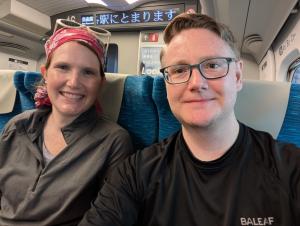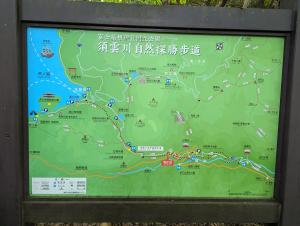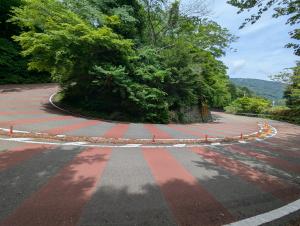Day 4 - Walking and Eating History
Tokyo - Hakone - Mishima
Today was our first buffet breakfast. It consisted of a mixture of traditional Japanese dishes like egg omelette (tamago), grilled salmon, sashimi or raw fish, tofu, miso soup, pork and potato stew, soba noodles, konyak, etc. There were also Western dishes such as toast, croissants, hard boiled eggs, scrambled, cereal, etc. After breakfast, we departed early with our luggage to travel on a shinkansen bullet train to Odawara.
A private bus (with a chandelier and gold edged curtains) awaited our arrival to take us to the beginning of today’s walk, which was over one of Tokaido's most famed passes. Here, part of the route still retains the ishidatami paving stones from the Edo Period, including old cedar trees from that time. We walked 8km (5 miles) with a total elevation gain of 610m (2,000ft). The terrain was rocky and muddy, as it rained the night before. The paving stones worn smooth from years of travel were quite slippery. It was absolutely gorgeous and worth the 2000ft vertical hike.
Near the top of our climb, we stopped at a thatched teahouse redolent of an earlier age. This tea house has been serving customers the same meal since the Edo period (1600s). Each person had two mochi cakes, one roasted with a soy sauce glaze and wrapped in nori (seaweed) and the other covered in roasted soybean powder. We also had a warm drink of amazuke which is a sweet drink made from sake lees, the leftover rice at the bottom of a sake barrel after fermenting. Everything we had as a snack was delicious. They've been making this same meal, using the same recipe, for almost 400 years.
Upon cresting the pass and descending to Lake Ashi-no-ko and the town of Hakone through an avenue of towering, centuries-old namiki cedar trees we enjoyed lushous views of the lake itself. At the lake shore, weather permitting, we enjoy an iconic view across the waters to Mt. Fuji and the torii gate positioned in the lake for the Hakone shinto shrine.
In the Edo Period, Hakone was also known for its sekisho barrier station, a checkpoint that controlled passage along the old highway; a place to be feared by travelers lacking the appropriate credentials. We visited the reconstructed sekisho or ancient customs and immigration stop for this post town in the Edo period and associated excellent museum before journeying on to Mishima, our overnight halt.
Since checking into our hotel accommodation, we’ve bathed and soon will venture out into town for dinner at a local izakaya restaurant. Tonight after dinner we plan to take in the onsen or public bath. Think of it as a hot spring.
Vote for your favorite
Cast your vote on the photo of the day to help decide who wins today's bonus points!
Who captured Mt. Fuji-san better?
Points earned today!
| L | Activity | J |
|---|---|---|
| 5 | Souvenir: Art | 5 |
| 1 | Mountain Panorama | 1 |
| 6 | Foodie (Unique foods) | 6 |
| 3 | Adventurous Eater | 3 |




